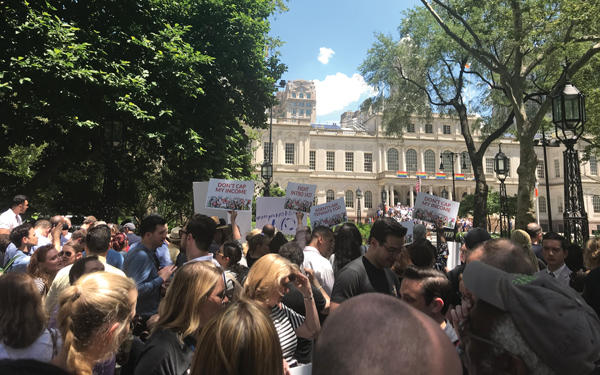Trending
REBNY starts singing a different tune
The trade group hopes to get by with a little help from its friends

Over the past few months, two occasional enemies on major real estate issues began quietly meeting.
James Whelan, the newly minted president of the Real Estate Board of New York, and Gary LaBarbera, president of the Building and Construction Trades Council of Greater New York, revisited an idea both had floated a few times during their decade-plus of battling over wages and work rules: joining forces.
This time, however, they actually negotiated in earnest. REBNY had just lost a crucial fight in Albany, failing to stop sweeping changes to the state’s rent-stabilization law. The unions in LaBarbera’s umbrella group had seen their market share eroded by nonunion construction. Both organizations needed an ally.
They agreed to an open-ended collaboration in which they would push for pro-development policies. “If developers aren’t building,” LaBarbera explained, “we won’t have the opportunity to put our members to work.”
But REBNY’s challenges are broader. Its crushing defeats on rent and on a New York City green-buildings law were possible because the industry has become politically toxic. That dynamic remains as city and state politicians prepare a slew of bills that directly threaten its members’ profits.
The deal with the Building Trades is part of an effort by REBNY and its new president to team up with unions, nonprofits and other organizations to salvage its agenda and its brand.
“There’s an acknowledgement that we have to do things differently,” Whelan, who had worked behind the scenes as REBNY’s political strategist until taking its helm, said in a sit-down interview at his stately Midtown office. “We understand that we need to change and adapt, and that will be an ongoing process.”
But some elected officials and industry leaders are dubious that REBNY can reverse the narrative. As a result, new real estate associations have formed, and some developers proposed legislation and lobbied on their own this past spring.
REBNY’s push to form coalitions, while significant, isn’t exactly novel — the group has employed it before, with mixed success. On the green-buildings legislation, it worked with the Natural Resources Defense Council (NRDC) to craft an alternative to a proposed carbon-emissions cap on large buildings.
But the bill passed anyway, showing that enlisting a credible partner from outside of real estate doesn’t guarantee REBNY’s messaging will be palatable to communities and their elected representatives.
 “The model of picking some well-placed allies and running roughshod over what the tenants want isn’t going to work,” said state Sen. Michael Gianaris, who elevated his profile by helping to kill Amazon’s planned Long Island City campus. “They need to be doing the listening and not worried about being listened to.”
“The model of picking some well-placed allies and running roughshod over what the tenants want isn’t going to work,” said state Sen. Michael Gianaris, who elevated his profile by helping to kill Amazon’s planned Long Island City campus. “They need to be doing the listening and not worried about being listened to.”
An “indefatigable” aide
More than a decade ago, faced with orchestrating one of the largest and most complicated rezonings in the city’s history — that of Hudson Yards — then-Deputy Mayor Dan Doctoroff knew exactly whom to call.
“It required a ballet. It required the management of hundreds of different actors,” Doctoroff recalled. “Jim was a master.”
Whelan and Doctoroff had first met in the early 2000s, when the former was executive director of the Downtown Brooklyn Council and advocating for rezoning the area. The deputy mayor found the thirtysomething operative “indefatigable,” and when the city began planning Hudson Yards, he made Whelan his chief of staff.
“I knew I needed someone who would wake up every day and just be relentless in getting the rezoning through,” Doctoroff said. “I hired him to be the guy who was going to drive Hudson Yards home.”
The rezoning passed, and Whelan, now 55, went on to an executive post at Muss Development. In 2010, he joined REBNY as senior vice president for public affairs, and five years later he was tapped to lead its political, communication and advocacy efforts.
Until succeeding John Banks as president in July, he avoided the limelight. But many in the real estate industry describe Whelan as politically adroit and nimble — and someone they trust to help REBNY regain its footing.
“The bottom line is, Jim is a brilliant political tactician. I think he understands that the politics have shifted,” said Jay Martin, head of another New York real estate trade group, the Community Housing Improvement Program. “The old way of doing things is no longer acceptable. The expectation that we have a one-on-one lobbying meeting, a donor fundraiser, and expect that favors can be called in — that’s gone.”
Martin noted that old-school REBNY members may require more convincing that they must alter their approach, despite ample warning signs in the past year: the demise of the state Senate’s Republican majority and its allied Independent Democratic Conference, the rise of Bronx and Queens Rep. Alexandria Ocasio-Cortez as a progressive leader, Amazon’s retreat from Long Island City and Gov. Andrew Cuomo’s failure to moderate the rent-law overhaul.
“I think it’s really affected politics in the city in a very deep way,” said lobbyist Suri Kasirer.
“Business and real estate are reeling and trying to figure out how to fight back, how do we tell our story.”
Real estate chess
Last month, REBNY hired a full-time organizer to focus on building coalitions like the one with LaBarbera’s group. Whelan said he also expects to work with building services union 32BJ — which has pull with many city and state elected officials — and the Regional Plan Association, an established planning nonprofit chaired by developer Scott Rechler.

REBNY has had some wins. After a long and tense showdown with LaBarbera and Cuomo, it reached a favorable compromise in 2017 on a successor to the 421a tax abatement. Last year, it got Albany to replace a proposed pied-à-terre tax with increased transfer taxes on high-priced home sales, and along with Uber was a key funder of a Riders Alliance campaign supporting congestion pricing, which the legislature approved this year.
Other campaigns haven’t been as successful, though. Taxpayers for an Affordable New York, a coalition of REBNY, CHIP and the Rent Stabilization Association that sought to minimize the damage to property owners in the rent law, saw nearly every tenant-friendly proposal adopted by the state legislature. And downstate, the City Council — determined to pass a green-buildings measure by Earth Day this year — disregarded suggestions by REBNY and the NRDC to make the bill fairer and more effective, in their view.
Some in the industry have decided to go around REBNY. Taconic Investment Partners’ Charles Bendit and A&E Real Estate Holdings’ Douglas Eisenberg submitted their own plan for revising the state’s rent law to legislators, though it ultimately went nowhere. Bendit, who has served on REBNY’s board of governors, said not to read too much into that. He said he likes working with REBNY, and though they may not always agree on “the exact direction of things,” they collaborate.
“I think that there are certain items on the legislative agenda that are more important to certain owners and operators than others. That will always be the case,” he said. “The tough thing for REBNY is they have to navigate the waters for all of their members.”
Residential brokers have also felt the need for more focused representation. The New York Residential Agent Continuum was created for residential brokers in 2018 and recently hired its own lobbyist and public relations firm. Founding member Heather McDonough Domi said the group is “planning a strong lobbying effort for the 2020 session in Albany.”
In a statement, she said, “Legislators and the governor’s office should expect to see our members’ faces in the halls of the state Capitol and to hear directly from real estate agents about the challenges they face every day as small business owners struggling to make it.” Her use of “small” and “struggling” to distinguish NYRAC members from the large, prosperous firms for which REBNY is known was perhaps no accident. (Whelan said that while the two groups sometimes don’t agree, he looks forward to working together.)
REBNY could hardly position its members as scrappy entrepreneurs, nor could it hope to generate public sympathy for the financial risk they shoulder on projects. Instead, Whelan said, his group needs to better tell the story of real estate’s importance to the economic health of the city. He stressed that a majority of the city’s property tax revenue comes from REBNY’s members, who create much-needed affordable housing. The trade group also needs to build relationships with more elected officials, he said.
“Those substantive conversations have to be based on data and good public policy, and not simply what’s in the best interest of the industry,” said Whelan.
But skepticism still abounds. Developer Don Peebles, who resigned from REBNY’s board of governors in 2016, said the organization is out of touch and doesn’t do enough to promote affordable housing.
“Their focus has been on protecting the status quo, as opposed to evolving with the change, where New York City is going today,” Peebles said. “The only thing they had going for them was money and influence. They don’t even have that going for them.”

Residential brokers, shown here protesting at City Hall in June, could be an asset in REBNY’s political efforts.
He intimated that Banks was pushed out as president because the organization failed to stop the new rent law, which severely limits rent increases on stabilized apartments. (Banks has said his decision to leave preceded the law’s passage.) Peebles, who like Banks is African-American, also emphasized that REBNY’s top staff doesn’t represent the demographics of the city.
“They expected John Banks to sell something that’s not sellable. Period,” Peebles said. “That’s a hell of a lift for anybody to do. Now they are having another white male articulating what they think is best for a city that is 53 percent women and 57 percent minority.”
REBNY declined to address Peebles’ comments. But Hazel Dukes, president of the New York chapter of the NAACP, which has worked with REBNY on issues in the past, said she felt Banks, its first black president, did help change the perception of the organization and that it was making diversity a greater priority.
“I think you will see a change,” she said. “I think Jim is amenable to seeing that happen.”
Mobilizing brokers
One point of tension for the 123-year-old trade group that hit a fevered pitch under Banks’ watch is its relationship with the residential brokerage community, which some say continues to play second fiddle to large developers.
In November 2018, Banks and Douglas Elliman Chair Horward Lorber got into a heated exchange in a closed-door meeting between REBNY and several brokerage chiefs to discuss allegations that Compass unfairly goes after other firms’ listings.
Lorber at the time said his frustration stemmed from what he believes is REBNY’s tendency to focus on commercial members at the expense of residential firms.
“When you look at the dues paid by the residential side — versus what the residential side gets compared to the commercial side — it’s not a fair allocation of revenue and expenses,” he said.
The trade group has ramped up its services for residential brokers in recent years. REBNY overhauled its Residential Listing System syndication service in 2017, and it has since implemented stricter data-sharing procedures to help clean up listing data. The RLS has 19,000 listings, but some in the industry have posited that it can’t rival StreetEasy, which has a budget significantly higher than the RLS’ annual $2.5 million and had nearly 17,000 for-sale listings and 13,000-plus rental listings in the city at the end of November.
Brown Harris Stevens CEO Bess Freedman said while there’s been a perception that REBNY focuses more of its energy on commercial brokerage and developer interests, she thinks Whelan has made clear that he’s going to change that dynamic.
“Jim Whelan is being extremely aggressive in trying to make sure that the needs of the residential community are being heard,” she said.
Freedman said that the voices of residential brokers — who are less politically toxic than developers or landlords — could also be beneficial to REBNY.
Diane Ramirez, chair and CEO of Halstead Real Estate, who serves on REBNY’s board, said she doesn’t feel the trade group has ignored residential brokers. But, she said, her sector needs REBNY’s representation in ways that it never has before. In June, REBNY helped organize a massive protest outside City Hall that helped stall a City Council bill to cap broker’s fees at one month’s rent, but brokers worry it will resurface.
They also expect state officials to revisit the pied-à-terre tax, which would be levied annually on second homes purchased for $5 million or more. Some in the industry fear that would chill luxury sales.
Whelan said mobilizing brokers will be an increasingly important part of REBNY’s advocacy.
“The brokerage community is a very important constituency, and it’s one, if organized, that can be a very effective voice, and we’ve seen that over the last year,” he said. “I think you’re going to see the brokerage community much more involved in the discussion moving forward.”
Ramirez said REBNY will prove essential in organizing brokers, but that individual agents need to make their voices heard.
“We’ve always counted on REBNY to look at the big picture, and that protected us legislatively,” she said. “But now the issues are getting very granular, and I think it’s going to need a shift. We can no longer count on REBNY to handle everything.”
The road ahead
Although the start of the next state legislative session is just a month away, the industry would be well served to build relationships with city officials eyeing other posts in 2021. Kasirer said that will be a crucial year as voters elect a new mayor, a new comptroller, a slew of new Council members and four new borough presidents.
“This is the time, for a lot of the groups out there, to really engage with the folks in office who are looking at higher office,” she said. “For the real estate community, this is an important time to think about how we educate the next leadership of the city.”
The immediate challenge, however, is today’s leaders, who are catering to constituents claiming that development triggers gentrification, raises rents and pushes residents out of neighborhoods. Gianaris said REBNY needs to learn that communities are “driving decision-making like never before.”
The senator warned, “If REBNY continues to pursue policies that are to the detriment of those people, they are going to continue having a problem.”
The trade group has struggled to sell one of its key messages: that increasing the supply of housing will make it more affordable. Its points about paying billions of dollars in real estate taxes and building affordable housing have also not resonated.
Whatever strategy it adopts to convey these themes, revamping its public image will not be a short-term endeavor.
“It’s not going to happen overnight,” Kasirer said. “There may be a period where it’s rough.”




